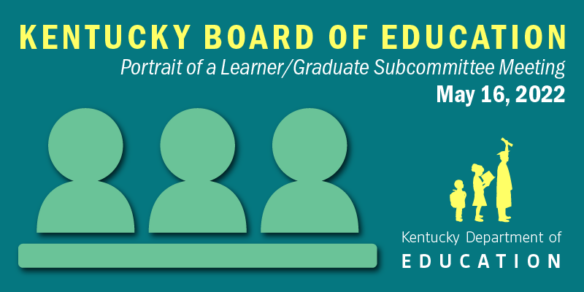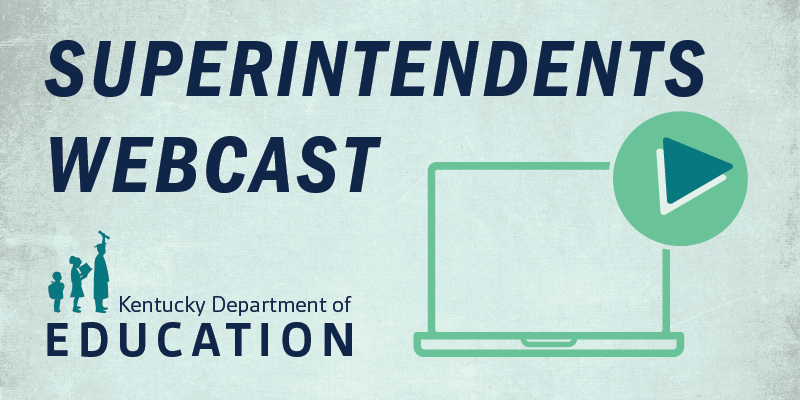 The Kentucky Board of Education (KBE) Portrait of Learner/Graduate Subcommittee met for the first time on May 16 to begin taking steps to create a vision statement describing what a learner should know and be able to do before they graduate high school.
The Kentucky Board of Education (KBE) Portrait of Learner/Graduate Subcommittee met for the first time on May 16 to begin taking steps to create a vision statement describing what a learner should know and be able to do before they graduate high school.
“As we move into the work of reimagining the learner experience for every public school child in Kentucky, I am excited for the Kentucky Board of Education to begin a deep dive into creating a statewide model for a portrait of a learner/graduate,” said KBE Chair Lu S. Young. “This work will center on building inclusive community partnerships to strike a new balance between the teaching of content and academic mastery, with skills and dispositions that will prepare every learner to be innovation-ready graduates and productive citizens of our Commonwealth.
“The charge for the subcommittee is to evaluate what should be in our portrait of a learner/graduate and how that can support and enhance the profiles that our public school districts have already adopted.”
One of the KBE’s current goals is a desire to “promote the creation of a statewide portrait of a learner/graduate, identifying the knowledge, skills and dispositions all Kentucky learners need to become successful citizens.” At its April 20 meeting, the KBE Curriculum, Instruction and Assessment Committee approved the creation of subcommittee to explore the development of a state-level portrait of a learner/graduate.
The subcommittee includes five KBE members and other education partners, including one postsecondary faculty member, a student from the Kentucky Student Voice Team and four representatives of the Kentucky Coalition for Advancing Education. The four members from the coalition represent parents; business owners and community members; teachers; and school/district administrators.
The first meeting focused on the history of a portrait of the learner/graduate in Kentucky, with the discussion led by David Cook, director of the Kentucky Department of Education’s (KDE’s) Division of Innovation, and Matthew Courtney, policy advisor for KDE’s Office of Continuous Improvement and Support.
This effort to build a statewide portrait began in 2017 under then-Commissioner of Education Stephen Pruitt as part of revising Kentucky’s Every Student Succeeds Act (ESSA) state plan. Pruitt formed the Educational Innovations Work Group, which recommended pursuing a competency-based education – an approach that gauges learning based on a student’s demonstration of understanding.
Pruitt directed KDE’s Division of Innovation to implement this recommendation and involve local school districts. The division formed the Kentucky Competency Education and Assessment Consortium (KCEAC), whose vision is to create a collaboration among districts committed to a systemic approach to competency education and assessment and, with the support of KDE, design and implement a competency education and assessment system.
Cook and his office opened an application for districts to apply to the consortium and two districts – Shelby and Trigg counties – met the evaluation criteria. Both districts already had portraits of a learner, and the two portraits had nearly identical key competencies. This helped KCEAC to create “Anchor Competencies” that formed the basis of the group’s initial work.
After researching portraits across the country and bringing together teachers from throughout Shelby and Trigg counties, the consortium found five anchor competencies that almost every portrait has: critical thinker, communicator, empowered learner, collaborator and engaged citizen.
Before the COVID-19 pandemic began in March 2020, the consortium had expanded to 11 school districts: Allen, Boone, Corbin Independent, Frankfort Independent, Jefferson, Logan, Mason, Metcalfe, Shelby, Trigg and Trimble.
With the launch of the Local Laboratories of Learning (L3) work last fall, many L3 communities have an interest in furthering their work on their portraits. The L3 communities are local and inclusive coalitions that are piloting new assessment, accountability and learning approaches. Of the 15 districts participating in Cohort 1 or 2 of the L3 work, nine were members of the consortium.
Cook said that though wording may be different than what some L3s currently have, conversations with the L3s have shown that the statewide model can act as a guide without taking away from the community-based work already done.
Members of the subcommittee offered their initial feedback to five anchor competencies and will go more in depth at their next meeting on their recommendations for the statewide model.
The next steps for the subcommittee are to report back to the KBE Curriculum, Instruction and Assessment Committee at its June 8 regular meeting.




Leave A Comment